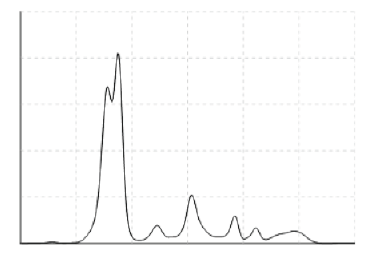Imaging cases
Biochemical clinical case
1.Department of Pediatrics, Centro Hospitalar Entre Douro e Vouga. 4520-211 Santa Maria da Feira, Portugal. nessajoana@gmail.com; cliromi@gmail.com
2.Department of Clinical Pathology, Centro Hospitalar Entre Douro e Vouga. 4520-211 Santa Maria da Feira, Portugal. jbeatriz81@hotmail.com; marianaspsilva@gmail.com
Abstract
Bisalbuminemia is a qualitative albumin variation defined by coexistence of two types of serum albumin with different electrophoretic mobilities in the same individual. It can be of two different types: hereditary (or permanent) and acquired (or transient).
Herein is described a rare case of hereditary bisalbuminemia in a healthy infant, incidentally found during elevated aminotransferase study.
Despite not having pathological significance, acknowledgement of this analytical alteration is key for adequate management of these patients.
Keywords: blood protein disorder; electrophoresis; serum albumin
Resumo
A bisalbuminémia é uma alteração qualitativa da albumina, definida pela coexistência de dois tipos de albumina sérica com mobilidade eletroforética diferente no mesmo indivíduo. Existem duas formas: hereditária (ou permanente) e adquirida (ou transitória).
É descrito um caso raro de bisalbuminémia hereditária num lactente saudável, acidentalmente detetada durante a investigação de aminotransferase elevada.
Apesar de não ter significado patológico, o reconhecimento desta alteração analítica é essencial para a adequada orientação destes casos.
Palavras-chave: albumina sérica; distúrbio de proteínas sanguíneas; eletroforese
A nine-month-old infant girl, previously healthy and with unremarkable family history, was referred to the Pediatric consultation due to elevated aminotransferase identified while investigating failure to thrive.
In the first assessment, although the patient achieved the original birth weight percentile, she kept hypertransaminasemia. Physical examination was normal. Complementary study found a bicuspid pattern in albumin fraction on serum electrophoresis (Figure 1). Total albumin variation was within the normal range.
Discussion
Assessment of renal function, total proteins, immunoglobulins, pancreatic enzymes, and thyroid function and abdominal ultrasonography were requested to exclude secondary causes of bisalbuminemia. Complementary studies showed no changes, and no therapy was instituted.
Given suspicion of a hereditary disorder, other family members were tested through serum protein electrophoresis, with the condition only confirmed in the mother.
During follow-up, the patient remained clinically asymptomatic and liver enzymes returned to the normal range, but no overt cause of hypertransaminasemia was identified.
This case describes bisalbuminemia findings in two family members, confirming its inherited nature. Genetic study has not yet been performed, as it has no implications in clinical management.
Bisalbuminemia represents a qualitative albumin variation, relatively rare and defined by a bicuspid pattern in the albumin fraction of serum protein electrophoresis. The modified albumin form may present increased (fast type) or decreased (slow type) electrophoretic mobility. (1)- (3
Bisalbuminemia may be inherited (or permanent) or acquired (or transient). Inherited bisalbuminemia has a frequency between 1:1000 and 1:100005 and may have an autosomal dominant form, being frequently found in several members of the same family. (1), (2), (4 The causative genetic lesion is a point mutation of human serum albumin gene, and more than 100 variants have been identified. Slow-type variants predominate in Europe. (3), (4
The modified albumin form generally has no pathological significance, but some albumin variants may have altered affinity for some hormones, metal ions, fatty acids, and drugs, with clinical implication in some cases. (4), (6 That is the case of familial dysalbuminemic hyperthyroxinemia and familial dysalbuminemic hypertriiodothyroninemia, which have been linked to inherited bisalbuminemia. (7), (8), (9 Mutations involved form a protein with preferential L-thyroxine or triiodothyronine affinity, resulting in increased total serum levels. (10
Bisalbuminemia diagnosis is established by first eliminating the main acquired etiologies: drug interference (mostly high doses of beta lactam antibiotics), acute pancreatitis, and binding of monoclonal immunoglobulins. (4
The present report described a rare case of hereditary bisalbuminemia in an infant after excluding other causes and investigating family members. Although this condition seems to have no clinical implications, it should be acknowledged to ensure the best management of these patients.
References
1. Neild GH, Chakraborty S, Sural S, Sen S. Serum electrophoresis with a bifid albumin peak. Clin Kidney J. 2012;5(6):607.
[ Links ]
2. Agarwal P, Parkash A, Tejwani N, Mehta A. Bisalbuminemia: A Rare Finding on Serum Electrophoresis. Indian J Hematol Blood Transfus. 2018;34(3):558-9.
[ Links ]
3. Angouridaki C, Papageorgiou V, Tsavdaridou V, Giannousis M, Alexiou-Daniel S. Detection of hereditary bisalbuminemia in a Greek family by capillary zone electrophoresis. Hippokratia. 2008;12(2):119-21.
[ Links ]
4. Bach-Ngohou K, Schmitt S, Le Carrer D, Masson D, Denis M. [Dysalbuminemia]. Ann Biol Clin (Paris). 2005;63(2):127-34.
[ Links ]
5. Shetty JK, Maradi R, Prabhu K, Bhat G. Bisalbuminemia in a Hypothyroid Patient with Diabetes: A Case Report. J Clin Diagn Res. 2015;9(9):BD01-02.
[ Links ]
6. Lefrere B, Dedome E, Garcia-Hejl C, Ragot C, Chianea D, Delacour H, et al. [Bisalbuminemia: A case report]. Rev Med Interne. 2018;39(12):950-4.
[ Links ]
7. Sunthornthepvarakul T, Likitmaskul S, Ngowngarmratana S, et al. Familial dysalbuminemic hypertriiodothyroninemia: a new, dominantly inherited albumin defect. J Clin Endocrinol Metab. 1998;83(5):1448-54.
[ Links ]
8. Petersen CE, Scottolini AG, Cody LR, Mandel M, Reimer N, Bhagavan NV. A point mutation in the human serum albumin gene results in familial dysalbuminaemic hyperthyroxinaemia. J Med Genet. 1994;31(5):355-9.
[ Links ]
9. Faviou E, Nounopoulos C, Dionyssiou-Asteriou A. Bisalbuminemia from a clinical chemist's viewpoint: a case report and review of the recent literature. Minerva Med. 2006;97(3):287-93.
[ Links ]
10. Kragh-Hansen U, Minchiotti L, Galliano M, Peters T, Jr. Human serum albumin isoforms: genetic and molecular aspects and functional consequences. Biochim Biophys Acta. 2013;1830(12):5405-17.
[ Links ]
















